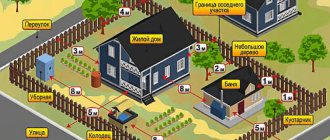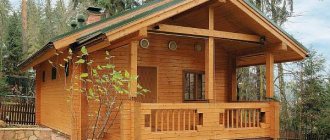The distance from the house to the neighbor’s fence is one of the necessary parameters that should definitely be taken into account when planning your new building site. A plan drawn up in accordance with building codes and regulations (SNiP) is necessary in order to arrange your land ownership as convenient and comfortable as possible. The main thing is that the law is not violated and no grounds are given for complaints from disgruntled neighbors or simply ill-wishers.
Suburban area
It is important that local authorities (whether it is the management in SNT or the local administration during the construction of individual housing construction) approve this plan. Distance standards during construction must also be observed for fire and sanitary safety.
Bathhouse construction standards and site requirements
The construction of a summer house is allowed on any type of plot within an urban and rural settlement, as well as on agricultural land. At the same time, the construction of a permanent structure is allowed for garden plots, and only temporary and outbuildings for garden land.
To build a bathhouse, the site must:
- located on an elevated area - to simplify the organization of drains;
- slope in any direction except north;
- soil with increased density and without swelling.
Bathhouse construction standards are regulated by:
- SP 30-102-99;
- SNiP 30-02-97.
Where and how can you build according to SNiP
According to existing rules, which were changed in 2015, a bathhouse can be built on almost any type of land tenure. To do this, it is sufficient to comply with current construction, hygiene and fire safety standards. The provision then required legislative action again in 2021.
Standards for installing wells and boreholes on the site
The adoption of changes in 2021 led to the introduction of additional adjustments to the rules for the operation of land plots. Now on a summer cottage you can build not only bathhouses, but also residential private houses, and in the absence of registration of an existing building with an area of less than 50 square meters. m, the dacha is recognized as having a garden house. The latter concept is legally defined as a new term.
On the territory of the DNT there can only be vegetable gardening or a non-profit gardening partnership; belonging to the latter, as a private household plot, individual housing construction, private ownership in the urban settlement, city limits and in the countryside, implies the possibility of building a residential building.
Minimum fire clearances
Previously, only temporary buildings were allowed on some types of property, but this year opens up the opportunity for former dacha cooperatives and SNTs to even obtain a registration address. This means that the land can be used for any type of building as long as it is essential for life support. The mentality of a Russian citizen rarely allows one to do without a bathhouse for those who have built their own residential private house.
Minimum distances between houses depending on their fire resistance
The video below talks about the minimum setbacks on the site when erecting buildings.
Distance to fence
Like any building, a bathhouse is a voluminous structure that can darken the neighboring area; it is also a source of increased fire safety.
According to SNiP, the distance from the bathhouse to the fence must be at least 3 meters, and it is important that the shadow of the building does not disturb the neighbors. The same distance must be maintained for the bathhouse sewer system if water is drained into a drainage pit. If there is a capital drainage trench with filtering components, for example, a mixture of graphite and sand, this distance can be reduced to 1 meter.
Distance to home
According to the standards, the distance of the bathhouse from the house depends on the materials from which it is built.
Minimum indicators:
- 8 meters for a brick bathhouse and a permanent house, both already built and under construction;
- 6 meters - if the bathhouse is wooden, but has a non-flammable roof, and the walls are impregnated with anti-flammable substances;
- 10 meters - if the bathhouse is completely wooden, and the house is made of brick or stone;
- 15 meters - if both objects are built from wood.
However, there are some nuances. For example, if there are no windows on the side of the neighbor's house facing your property, you can reduce the distance to it to 1 meter. And if you plan to heat the bathhouse with wood, the distance from other buildings should be maximum, and the smoke should not go towards the neighbors.
To measure the distance, take the protrusion of the base, and if there is none, the wall. Any protruding structure greater than 0.5 meters must be taken into account and used as a reference point. This requirement must be observed even when buildings are located on the same site.
Distance from bathhouse to bathhouse
Regardless of the type of building, standard guidelines apply for determining the distance between objects. This means that the distance from a bathhouse to another bathhouse should be the same as to a residential building - from 7 to 8 meters, depending on the construction materials.
Distance from red line
Ground and underground communications that run near the site are called the red line. According to sanitary standards, the bathhouse, like any other structure, must be at least 5 meters away from it. If the red line does not pass close to the site, you can reduce the distance between the bathhouse and the fence to 1 meter, provided that a distance of 5 meters is maintained between the building and the communications line.
Distance from natural bodies of water
If there is a river, canal or other natural body of water near the site, you need to take into account that the territories adjacent to the coastline are water protection zones (Part 1 of Article 65 of the Water Code of the Russian Federation).
According to Part 5 of Art. 65 VK, the distance at which buildings can be located depends on the length of the reservoir:
- from 50 meters, if its length is up to 10 km;
- 100 meters if from 10 to 50 km;
- 200 meters if from 50 km or more.
If the length of a river or stream is less than 10 km, only the coastal strip is a water protection zone.
Distance from trees to fence - planting standards according to SNIP
The height of the fence between neighbors in a private house according to the law
Removing buildings based on material of manufacture
The distance between the main and auxiliary building buildings determined by the standards prevents the transfer of flame to neighboring buildings in the event of a fire. This takes into account the material from which they are made, as well as the possibility of approaching them around the perimeter. That is, at the design stage, any factors that impede the provision of assistance in the event of an emergency are excluded.
Country cottage area
What distance should be between permanent buildings on your own and neighboring plots is indicated in the list below:
- Between stone, cast concrete, prefabricated reinforced concrete – 6 meters.
- The above type, but with floors made of wooden or non-flammable materials - 8 meters.
- Wooden frame buildings with the same fencing can be built at a distance of 15 meters.
- There is 6 meters between the stone fence and buildings with wooden floors.
- From stone fences (for example, brick, bordering frame buildings) - 10 m.
- The boundary between the wooden frame fence and the stone buildings is 6 m.
- From fences with a wooden frame to buildings with a wooden ceiling, the setback is 8 m.
- A fence with a wooden frame should be located 10 m from buildings made entirely of wood.
- The distance to the fence bordering the stone buildings with wood floors is 10 m.
Near the forest
Basic requirements for development
The procedure for planning buildings on your own site is the right of the owner, but sanitary standards and the rights of neighbors must be respected.
To avoid disputes regarding the placement of the bathhouse, you must strictly take into account:
- maintaining the distance to the neighboring fence to avoid complaints from neighbors to supervisory authorities;
- compliance with sanitary requirements and elimination of contamination of drinking water sources;
- take into account the direction of winds in the area so that smoke does not fall into the neighboring area;
- choose elevated areas for placement to prevent flooding in the spring and autumn;
- try to locate the entrance on the south side, where the snow melts faster - this way access to the bathhouse will be as simple as possible;
- take into account regional characteristics and requirements for the construction of this type of structure;
- negotiate with neighbors to reduce the distance if it is impossible to comply with the legal requirements for the placement of a bathhouse.
In the latter case, the agreement must be concluded in writing and certified by a notary. There is no point in building a bathhouse after your neighbor has verbally assured you that there are no complaints; it is better to secure all agreements legally and protect yourself for the future. However, it is worth considering that such an agreement is valid only with the current owner; if the neighboring plot is sold or it is inherited, you will have to re-negotiate with the new owner.
Fire safety
These requirements are regulated by the Federal Law of December 21, 1994 “On Fire Safety” No. 69-FZ.
Basic rules to consider:
- presence of a fire extinguisher;
- fire resistance or protective coating of materials in contact with the stove;
- compliance with the maximum heating of the walls up to 120 degrees;
- placing a metal sheet in front of the firebox to prevent fire in the event of ash or firebrands falling out;
- organizing a thermal gasket where the pipe passes through the ceiling; direct contact may cause the wooden roof to catch fire;
- high-quality ventilation that effectively frees the room from carbon monoxide in an emergency;
- inviting a representative of the fire service to start the stove for the first time and drawing up a fire safety report.
If the last requirement is not met and the first launch is carried out independently, you need to pay attention to:
- heating of elements - it must be uniform for all parts of the structure; if some are too hot, additional protective coating will be required;
- draft - when heating, smoke should not leak into the room through the cracks, and if there is no draft, it is necessary to clean the chimney.
For fire safety reasons, it is not recommended to lock the door during bath procedures.
Sanitary standards
In order for the bathhouse to be safe for the environment, you need to pay attention not only to the distance from other objects, but also to other indicators:
- individual sewage system in the absence of a central sewerage system;
- chimney tightness;
- uninterrupted operation of valves;
- the use of facing materials from environmentally friendly products so that toxic substances are not released - cheap plastic or chipboard cannot be used, and polystyrene foam is not allowed as insulation;
- equipped ventilation that prevents the formation of condensation and high humidity.
Types of fencing
A wide range of building materials allows you to install an inexpensive fence both from the street and to protect yourself from neighbors in order to hide from prying eyes.
Let's highlight the most popular and affordable types of fencing:
- Shield. It is assembled from wooden boards fastened to a frame made of timber. Has the shape of a rectangle. The standard length is 1.8 m. The material on the board is located horizontally or vertically. Sold ready-made. However, they should be treated with antiseptics and fire retardants. A popular species is pine.
- Trellis. Decorative, but not protective fencing. Wooden slats are connected to each other into squares. The trellis requires painting.
- Palisade Available for sale in rolls. Wooden stakes are installed close to each other. Can be reinforced with steel wire. The fence is quite strong, but not very attractive to look at.
- Rabitz. It is used as a fence when arranging a barn, a place for walking livestock, poultry in the village. It is not practical to use in the city, since the entire yard will be clearly visible.
- Fence. You can build such a fence low, up to 10 cm, as a fence for a flower bed, or high, to close the area from the street. Wooden planks are placed vertically and nailed to horizontally laid beams.
Fences made of corrugated sheets, metal with forged elements, brick, and stone will cost much more. Such a fence will be more reliable, durable and beautiful.
Barbed wire can be used as a material no lower than 2 m from the ground, so as not to cause injury to surrounding people.
If a fence is installed to separate two vegetable gardens, then its height and design should not block the flow of light or disrupt air exchange. Chain-link and picket fence are well suited for this.
It is worth highlighting situations when, before building a fence, owners need to obtain permits from the relevant services:
- the boundaries of the territory are not included in the cadastral plan;
- the land is located in the vicinity of architectural monuments and industrial facilities;
- The building area is quite small and because of this it is not possible to adhere to GOST standards.
In the latter case, BTI employees who understand all issues related to home ownership can help.
If a neighbor built a bathhouse too close - what to do?
If a neighbor has started building a bathhouse in violation of the standards, you should contact him as soon as possible, because dismantling the building is easier in the early stages. But before you start a dispute, it is important to make sure that you have:
- correct cadastral passport;
- land survey plan;
- ownership.
For example, if we are talking about the plot of elderly parents, they may not have the entire package of documents, which will lead to the extra plot of land being transferred to the neighbor. You also need to make sure that none of the family members gave permission for this construction.
Having clarified these questions, you should contact your neighbor and explain to him that he is violating your civil rights and if he does not dismantle the building, you will have to deal with your defense in an administrative or judicial manner.
Regardless of which method of struggle you choose, it is worth sending a registered letter to your neighbor demanding that the construction defects be eliminated. It will serve as evidence of attempts on your part to resolve the issue peacefully.
Resolving the conflict administratively
If a neighbor refuses to clean a bathhouse built without compliance with regulations, you can file a complaint:
- to the local administration;
- the chairman of a garden non-profit partnership or a dacha non-profit partnership;
- to the prosecutor's office.
The complaint is drawn up in free form, observing the rules of business correspondence and indicating:
- these parties;
- the essence of the appeal - the presence of an illegal building in violation of regulations;
- listing the points of violation;
- demand for their elimination;
- dates and signatures.
Sample complaint
Sample complaint
It is also possible to draw up a collective appeal, for example, if an illegally installed bathhouse pollutes groundwater or soil.
All types of complaints are drawn up in the number of copies corresponding to the number of participants in the conflict, in the case of a collective appeal - according to the number of signatories. The document can be submitted in person (with a mark of acceptance) or sent by registered mail.
Going to court
If the dispute cannot be resolved pre-trial, you should go to court. In this case, it is possible to achieve not only the demolition of the unauthorized building, but also compensation for moral and material damage (for example, if the darkening of the bathhouse area prevented the uniform growth of the crop), as well as legal costs.
The statement of claim is drawn up according to the standard provisions of Art. 131 of the Code of Civil Procedure of the Russian Federation and indicating the same data as in the complaint, as well as information about attempts to resolve the issue pre-trial and the refusal of the neighbor to independently eliminate the violations.
Sample claim
Attached to it:
- passport;
- copies of pre-trial appeals;
- documents confirming your position: cadastral passport, land survey plan, act of illegal construction (if it is drawn up), etc.
The specific list depends on the situation.
Package of documents for registration
Before contacting the authorized bodies, you should prepare:
- Owner's passport. If a representative is applying, a notarized or general power of attorney is required.
- Application according to the established form. The address of the future building must be indicated.
- Documents confirming ownership (this is an extract from the Unified State Register, a certificate of the owner).
- Boundary plan of the site.
- Construction permit (if the construction is major).
- Project documentation. Here the technical parameters of the future building, dimensions, number of rooms, equipment for organizing heating are indicated. As well as selected building materials.
- Data on engineering communications. Here are the layout diagrams for wastewater and drainage systems.
- Receipts proving payment of state fees.
Contacting the authorized bodies is carried out in person or through a proxy. The package of documents can be sent by mail. Another simple way to submit an application is through the MFC. After receiving the documents, the data will be checked. They will determine whether the planned facility complies with urban planning standards. Lack of response within 7-10 days is a sign that no violations were detected. Construction can begin within 10 years. Refusal is possible if the construction violates the norms or if not all required documents are attached.
After completing construction, the owner re-notifies the administration for inspection. After which the object is registered in Rosreestr.
Arbitrage practice
The Kamensky City Court of the Penza Region considered case No. 2-22/2015, in which the plaintiffs demanded that the defendant demolish a bathhouse built in violation of town planning and construction standards, as well as fire safety and sanitary standards. The building is located too close to the site, and the slope of the roof is directed towards the plaintiffs' buildings. At the same time, the defendant stated that there was an oral agreement with the previous owner, who had no claims against him.
The court, having examined the case materials, took into account the absence of complaints from the previous owner, as well as the fact that the bathhouse was built in 2004, and the plaintiffs received ownership in 2011. At the same time, the fact of non-compliance with construction standards was established, but in itself it does not violate the rights of the plaintiffs and does not create a threat to their life and health, especially since the bathhouse has been operating since 2004 and no evidence was presented to the court that it is a source of danger.
Thus, the court refused to satisfy the claim in full, taking into account the fact that the demolition of the bathhouse significantly upsets the balance of interests of the defendant, and the plaintiffs did not present any other means of defense.
Responsibility for non-compliance with building regulations
Often, ignoring the requirements of current legislation leads to quarrels between neighbors, lengthy trials, and the imposition of fines. To avoid such a situation, even before the start of construction, all issues related to the distances from buildings to the fence should be agreed upon with them. This is especially true for situations when permission is required to go a little onto their site due to the small area of yours or it is necessary to replace the old adjacent fence with a new one higher. Such civil agreements are notarized, and even if your neighbors change, there will be no claims against you.
If the disagreement cannot be resolved peacefully, then the most effective way is to contact the prosecutor’s office with a written request to check the legality of the location of buildings and a fence on a neighbor’s property.
Compliance with legal norms is reliability and a guarantee of the legality of the development, the absence of claims from other parties, the ability to avoid lengthy litigation, saving time and health.
Lawyer's answers to private questions
A neighbor built a bathhouse close to my site, and besides, the slope of the roof is directed in my direction, causing snow and rainwater to flow onto my land. Where should I go to solve this problem?
You can file a complaint with the administration or prosecutor's office about illegal construction, as well as go to court. But before contacting the authorities, send a written request to your neighbor to eliminate the violations by registered mail.
Where to apply for a permit for a bathhouse if new neighbors complain that the construction is illegal, although it is in the BTI plan?
First contact the administration of your city with a request to legalize the design, and then go to court.
There is an old bathhouse, which was built on the adjacent territory of an apartment building. Recently, a neighbor complained about an illegal construction, and I received a notice of a fine of 5 thousand rubles. What do you think is easier: pay a fine and then legalize the bathhouse, or is it easier to demolish it?
If it is built on the territory of an apartment building, you will not be able to legalize it, especially since at least one neighbor is against it. Better demolish the structure and avoid the risk of repeated fines.
We added a bathhouse to our house wall to wall. The distance to neighbors is 5 meters, the size of the plot is 10 acres. Is it possible to get permission for it now or will I have to demolish the bathhouse as an illegal building?
If the distance requirement from neighbors is met, there is no reason for demolition. Contact the BTI, obtain technical and cadastral passports and register ownership in Rosreestr.
A neighbor built a dacha right next to my fence, it shades my area, and besides, smoke from the steam room is constantly coming towards me. What to do?
There are obvious violations of construction standards, so you can complain to the administration or file a lawsuit. In each case, the neighbor will be required to demolish the illegal building or remodel it in accordance with construction standards.
What are the consequences of not registering?
The new bill is effective from March 1, 2021. From this date, all buildings that are capital, but have not passed state registration, are considered unauthorized.
How does this threaten the owner: it will not be possible to install sewerage, electricity, water; a plot on which there are such buildings cannot be sold, changed, bequeathed or donated.
The owner will have to legitimize the structure. It will be necessary to prove that it complies with established standards. But in some cases this is not possible. For example, making a real estate item movable property. You will have to go to court and order an examination. The owner may be required to demolish the structure at his own expense. If this requirement is not met, a fine may be imposed.
Bill No. 301854-7 on liability for non-compliance with the requirements of the Civil Code establishes the following fine amounts:
- from 2000 to 5,000 rub. – initial amount;
- in case of late payment, the amount of the fine will increase from 20,000 to 50,000 rubles;
- The demolition of the building is carried out at the expense of the owner of the dacha plot.
Decor
It is also necessary to draw up your development plan in compliance with all necessary requirements. First, the appropriate permits are collected and a project is developed, which is agreed upon by all necessary authorities. After construction, the competent services draw up an act of acceptance and commissioning of the facility, which must be registered with the BTI.
You can, of course, do things differently and try to agree on a plan with some shortcomings. But at any moment this could result in a series of lawsuits and worsening relations with fellow villagers. Your reputation will suffer, and corrective action will become more difficult over time.











